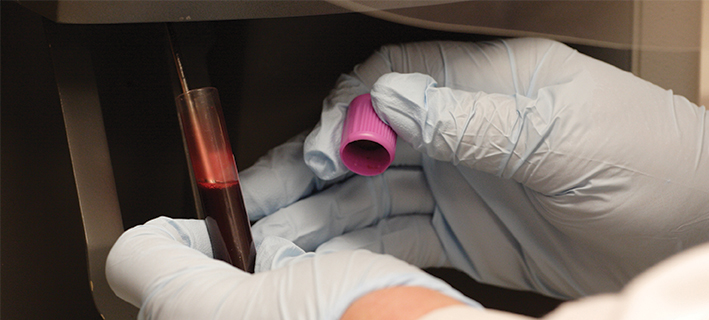
Laying the groundwork for treatment
There are literally hundreds of types of cancer that can occur in the human body. Knowing what type of cancer you’re dealing with will be the foundation for every aspect of your treatment.
At Virginia Cancer Institute, we ensure that the latest technology is used to diagnose your cancer and determine its type, stage and characteristics.
What is a cancer diagnosis?
Cancer may be detected when symptoms or abnormalities, such as a lump or growth, are recognized by a patient or doctor. After a cancer is detected, it still must be carefully staged.
When making a diagnosis, the doctor investigates the initial signs and symptoms through a variety of tests to identify whether cancer is causing them, and if so, what type of cancer it is. For example, breast cancer may be detected when a patient notices a lump, but it must be carefully evaluated with a number of tests to determine an accurate diagnosis. The diagnosis describes what type of breast cancer it is (i.e., “ductal” if it started in the ducts of the breast or “lobular” if it started in the lobes) and how advanced it is.
How is cancer diagnosed?
Diagnosing cancer involves the use of a variety of tests that provide details about abnormal cells, which may have been detected through routine medical examinations, self-examination or reported symptoms. More information about these cells must be gathered to identify them as malignant (cancerous) or nonmalignant (noncancerous), and if they are malignant, to determine how serious (aggressive) the particular cancer cells are. Aggressive cancers grow and spread more quickly than less aggressive or “indolent” cancers. There are many types of tests specifically designed to evaluate cancer:
- A pathology report is the observation of abnormal cells under a microscope.
- Diagnostic imaging involves visualization of abnormal masses using high-tech machines that create images, such as x-rays, computed tomography (CT), positron emission tomography (PET), magnetic resonance imaging (MRI) and combined PET/CT.
- Blood tests measure substances in the blood that may indicate how advanced the cancer is or other problems related to the cancer.
- Tumor marker tests detect substances in blood, urine or other tissues that occur in higher-than-normal levels with certain cancers.
- Special laboratory evaluation of DNA involves the identification of the genetic makeup—the DNA—of the abnormal cells.
For more information about diagnostic tests, visit the Testing Center.
What is a cancer stage?
Following a diagnosis of cancer, the most important step is to accurately determine the stage of cancer. Stage describes how far the cancer has spread. (Some cancers, such as leukemia, may not be staged.) Each stage of cancer may be treated differently. For you to begin evaluating and discussing treatment options with your healthcare team, you need to know the correct stage of your cancer.
There are many staging systems, but TNM is the most common. “T” refers to the size of the tumor, “N” to the number of lymph nodes involved and “M” to metastasis. TNM staging measures the extent of the disease by evaluating these three aspects and assigning a stage, which is usually between 0 and 4. Generally, the lower the stage, the better the treatment prognosis (outcome).
- Stage 0 – precancer
- Stage 1 – small cancer found only in the organ where it started
- Stage 2 – larger cancer that may or may not have spread to the lymph nodes
- Stage 3 – larger cancer that is also in the lymph nodes
- Stage 4 – cancer in a different organ from where it started
How does diagnosis determine treatment?
Historically, a combination of pathological assessment (laboratory evaluation using a microscope) and diagnostic imaging has been used to identify the type of cancer and its stage, and then the treatment.
Stage indicates how extensive the cancer is and how much it has spread. Staging usually involves determining the size of the primary tumor and evaluating whether it has remained in the tissue in which it started, whether it has invaded other nearby organs or tissues and whether cancer cells have spread to distant locations in the body. The cancer is then assigned a stage on a predetermined scale of numbers and letters: stage I, II, IIIa, IIIb, IV, etc. A higher number and letter combination indicates more extensive spread and, therefore, a more serious condition.
Treatment is often selected based on the stage of disease and the goal of therapy.
How is prognosis determined?
The probable course and/or outcome of the cancer is called the prognosis. Identifying factors that indicate a better or worse prognosis may help you and your doctor plan your treatment. Many factors help determine your prognosis, including:
- Your age
- Size of your cancer
- Stage of your cancer
- Aggressiveness of your cancer (cancer cells that are growing and dividing rapidly are considered more aggressive)
- Your general health
Your doctor will evaluate all possible factors to determine your prognosis.
Currently, the genetic makeup of cancer is being recognized as an important prognostic factor. For example, some genes have been associated with an aggressive course or tendency to recur in some specific types of cancer. Identification of these in an early-stage cancer may indicate a poor prognosis. Some research suggests that the genetic makeup of the cancer may be even more important for determining prognosis than the stage of the cancer.
